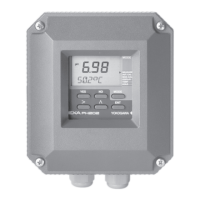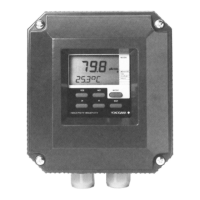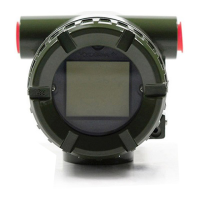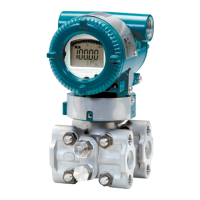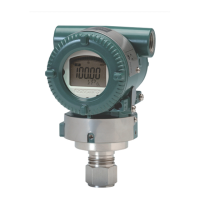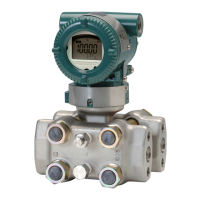Do you have a question about the YOKOGAWA PH202G and is the answer not in the manual?
DANGER, CAUTION, WARNING notes regarding electrical discharge, handling, and environment.
Information on manual usage, changes, accuracy, and Yokogawa's responsibilities.
Inspect instrument upon delivery and understand its intended use in industrial installations.
Details input, output, serial communication, display, power supply, and load resistance.
Lists performance specs for pH, ORP, temperature, ambient operating temp, and housing.
Explains how to interpret model and suffix codes for transmitter configuration.
Guidelines for choosing a site and methods for mounting the EXA transmitter.
Details the types of cables, terminals, and glands used for connecting the PH202.
Provides precautions and guidelines for wiring sensors and connecting the power supply.
Overview of the operator interface, access levels, and explanation of operating keys.
Illustrates how different parameters (pH, ORP, rH, temperature, output) are displayed.
Outlines standard operations like automatic calibration, manual calibration, and impedance checks.
Explains how to configure output range, hold function, and access service settings.
Covers settings for auto-return, passcodes, error messages, and communication setup.
Step-by-step guide for automatic calibration using buffer solutions.
Step-by-step guides for manual and sample calibration, including ORP calibration.
Covers cleaning the transmitter, maintaining housing integrity, and sensor cleaning.
Explains the analyzer's self-diagnostic functions and lists error codes with causes and remedies.
Details on-line and off-line impedance checks for sensor diagnostics.
Summarizes settings and provides a checklist for PH202G configuration.
Guidance on selecting appropriate sensors, temperature sensors, and calibration methods.
Illustrates wiring for different systems and sensor connection procedures.
Details on checking ORP electrodes and performing ORP calibration.
Specifies procedures and standards for insulation resistance and dielectric strength tests.
Outlines procedures for checking current output, temperature, pH, and ORP indications.
DANGER, CAUTION, WARNING notes regarding electrical discharge, handling, and environment.
Information on manual usage, changes, accuracy, and Yokogawa's responsibilities.
Inspect instrument upon delivery and understand its intended use in industrial installations.
Details input, output, serial communication, display, power supply, and load resistance.
Lists performance specs for pH, ORP, temperature, ambient operating temp, and housing.
Explains how to interpret model and suffix codes for transmitter configuration.
Guidelines for choosing a site and methods for mounting the EXA transmitter.
Details the types of cables, terminals, and glands used for connecting the PH202.
Provides precautions and guidelines for wiring sensors and connecting the power supply.
Overview of the operator interface, access levels, and explanation of operating keys.
Illustrates how different parameters (pH, ORP, rH, temperature, output) are displayed.
Outlines standard operations like automatic calibration, manual calibration, and impedance checks.
Explains how to configure output range, hold function, and access service settings.
Covers settings for auto-return, passcodes, error messages, and communication setup.
Step-by-step guide for automatic calibration using buffer solutions.
Step-by-step guides for manual and sample calibration, including ORP calibration.
Covers cleaning the transmitter, maintaining housing integrity, and sensor cleaning.
Explains the analyzer's self-diagnostic functions and lists error codes with causes and remedies.
Details on-line and off-line impedance checks for sensor diagnostics.
Summarizes settings and provides a checklist for PH202G configuration.
Guidance on selecting appropriate sensors, temperature sensors, and calibration methods.
Illustrates wiring for different systems and sensor connection procedures.
Details on checking ORP electrodes and performing ORP calibration.
Specifies procedures and standards for insulation resistance and dielectric strength tests.
Outlines procedures for checking current output, temperature, pH, and ORP indications.
| Brand | YOKOGAWA |
|---|---|
| Model | PH202G |
| Category | Transmitter |
| Language | English |

